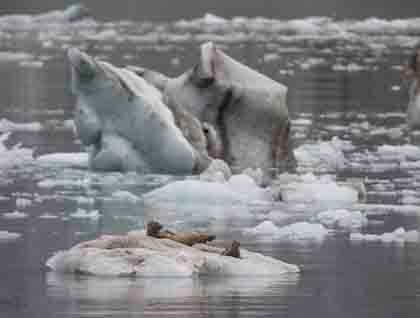We woke up early in the morning with the sound of ice alongside the hull; small pieces of glacial ice, known as “growlers,” surrounded the National Geographic Sea Bird on her approach to the northern end of the large Glacier Bay. We arrived to the magnificent Margerie glacier before breakfast and had the incredible opportunity to spend an hour in front of it, admiring its beautiful looks, listening to its multiple sounds, and eagerly waiting for some calving. Margerie didn’t disappoint us and regaled us with several impressive large chunks of ice falling to the water, followed by loud thunders. We also had the chance to admire the intriguing Grand Pacific glacier right next to the Margerie. Grand Pacific is the glacier responsible for the carving of the whole bay but now is barely recognizable as a glacier due to all the dirt and rocks that cover its face, giving it the appearance of an innocent hill.
After leaving those two glaciers, we headed towards Russell Cut and later to the Johns Hopkins Inlet, where we spent a great time navigating around growlers, bergie-bits, and icebergs until we arrived in front of the Johns Hopkins glacier. We engaged in the same enjoyable activities that we did in the Margerie, plus another one: harbor seal watching! The Johns Hopkins Inlet is home to an abundant population of seals that rest and give birth to their pups on the floating ice in front of the glacier, where they are safe from land predators like bears or wolves. We observed many adult harbor seals and pups and took lots and lots of pictures.
We crossed the bay once again and searched for wildlife along its eastern shore; a solitary brown bear was spotted walking on top of a hill, and numerous bald eagles crowned many trees and rocks. The mysterious-looking hill known as Gloomy Knob presented us with several beautiful mountain goats, including one not very high above the water that we all watched for a long time. Crossing the bay again, we searched the corners of Geike Inlet, where we encountered numerous sea otters. After leaving Geike, the National Geographic Sea Bird headed towards South Marble Island, where a cacophony of marine birds and Steller sea lions greeted us. We all had a great time watching the abundant black-legged kittiwakes, pigeon guillemots, horned and tufted puffins, pelagic cormorants, and glaucous-winged gulls. Later, an after-dinner visit to the park’s headquarters at Bartlett Cove allowed us to do some nice hiking in the forest or go for a power walk, making a great way to finish a marvelous day in Glacier Bay National Park and Preserve.







